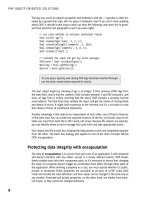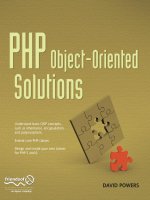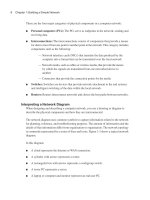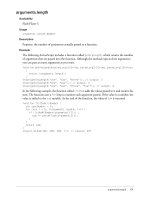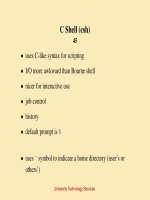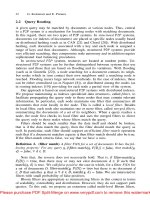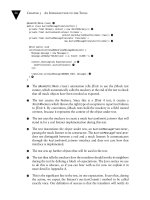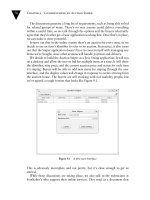Tài liệu PHP Object - Oriented Solutions P2 ppt
Bạn đang xem bản rút gọn của tài liệu. Xem và tải ngay bản đầy đủ của tài liệu tại đây (511.86 KB, 20 trang )
The way you access an object’s properties and methods is with the -> operator (a dash fol-
lowed by a greater-than sign, with no space in between). Even if you don’t know anything
about OOP, it shouldn’t take long to work out what the following code does (try to guess,
and then read the next paragraph to see if you were right):
// use class methods to validate individual fields
$val->isInt('age');
$val->removeTags('name', 0, 0, 1);
$val->checkTextLength('comments', 5, 500);
$val->removeTags('comments', 0, 0, 1);
$val->isEmail('email');
// validate the input and get any error messages
$filtered = $val->validateInput();
$missing = $val->getMissing();
$errors = $val->getErrors();
The $val object begins by checking if age is an integer. It then removes HTML tags from
the
name field, checks that the comments field contains between 5 and 500 characters, and
strips all tags from it before checking that the
email field contains a properly formed
email address. The final three lines validate the input, and get the names of missing fields
and details of errors. It might look mysterious at the moment, but it’s a lot easier to read
than dozens of lines of conditional statements.
Another advantage is that objects are independent of each other, even if they’re instances
of the same class. You can create two separate instances of the
Pos_Validator class to val-
idate user input from both the
$_POST and $_GET arrays. Because the objects are separate,
you can identify where an error message has come from and take appropriate action.
Each object acts like a black box, keeping the data passed to each one completely separate
from the other. The black box analogy also applies to one of the main concepts behind
OOP: encapsulation.
Protecting data integrity with encapsulation
The idea of encapsulation is to ensure that each part of an application is self
-contained
and doesn’t interfere with any others, except in a clearly defined manner. OOP breaks
down complex tasks into their component parts, so it’s necessary to ensure that changing
the value of a property doesn’t trigger an unintended chain effect through other parts of
the application. When defining a property in a class, you must specify whether it’s public,
private, or protected. Public properties are accessible to all parts of a PHP script, both
inside and outside the class definition, and their values can be changed in the same way as
any variable. Protected and private properties, on the other hand, are hidden from exter
-
nal scripts, so they cannot be changed arbitrarily.
To save space, opening and closing PHP tags have been omitted through-
out this book, except where required for clarity.
PHP OBJECT-ORIENTED SOLUTIONS
8
10115ch01.qxd 7/10/08 1:12 PM Page 8
Methods can also be public, protected, or private. Since methods allow objects to do
t
hings, such as validate input, you frequently need them to be public. However, protected
a
nd private methods are useful for hiding the inner workings of a class from the end user.
You’ll see how this works in the next two chapters when you start working with actual
code, but one of the properties of the
Pos_Validator class is $_inputType, which deter-
mines whether the input being validated comes from the
$_POST or $_GET array. To pre-
vent the value of
$_inputType from being changed, the class definition declares it
protected like this:
protected $_inputType;
The value of $_inputType is set internally by the class at the time of instantiating the
object. If you attempt to change it directly, PHP generates a fatal error, bringing everything
to a grinding halt. Inconvenient though this might sound, this preserves the integrity of
your code by preventing an attacker from tricking a validation routine to handle variables
from the wrong type of source. As long as a class is well designed, encapsulation prevents
the values of important properties from being changed except by following the rules laid
down by the class.
Encapsulation also makes the final code much simpler and easier to understand, and this is
where the example of a car as an object begins to make sense. Unless you’re a motor
mechanic or enthusiast, you don’t need to know the details of the internal combustion
engine to get in a car and drive. It doesn’t matter whether it’s an old-fashioned gas guzzler
or one that runs on biofuel; all you need to do is turn on the ignition and put your foot
down on the accelerator. What this means in terms of OOP is that you can create a class
with a method called
accelerate(), and the user doesn’t need to worry about the internal
code. As long as the
accelerate() method performs the expected task, the user is happy.
This leaves the developer free to make improvements to the method’s internal code with-
out forcing users to make similar changes throughout their own scripts. If you’re working
on your own, this might not seem all that important, as you’re both the developer and end
user. However, if you’re working in a team, or decide to use a third-party class or frame-
work, knowing what goes on inside the black box of the object is irrelevant. All you want
to know is that it works and provides consistent results.
Encapsulation is a great advantage for the end user, but it places an important responsibil-
ity on the developer to ensure that changes to the internal code don’t produce unex-
pected changes in output
. If a method is expected to return a string, it shouldn’t suddenly
return an array. The black box must work consistently. Otherwise, all dependent code will
be affected, defeating the whole purpose of OOP
.
Closely related to this is another key feature of OOP: polymorphism.
It’s a common convention to begin the names of protected and private properties with
an underscore as a reminder that the property’s value should be changed only in strictly
controlled circumstances. You’ll learn more about public, protected, and private prop-
erties and methods in the next chapter.
WHY OBJECT-ORIENTED PHP?
9
1
10115ch01.qxd 7/10/08 1:12 PM Page 9
Polymorphism is the name of the game
I
n spite of its obscure-sounding name,
p
olymorphism
i
s a relatively simple concept. It
applies to both methods and properties and means using the same name in different con-
texts. If that doesn’t make it any clearer, an example from the real world should help. The
word “polymorphism” comes from two Greek words meaning “many shapes.” A human
head is a very different shape from a horse’s head, but its function is basically the same
(eating, breathing, seeing, and so on), so we use the same word without confusion. OOP
applies this to programming by allowing you to give the same name to methods and prop-
erties that play similar roles in different classes.
Each class and object is independent, so method and property names are intrinsically asso-
ciated with the class and any objects created from it. There’s no danger of conflicts, so
when a method or property is used similarly in different classes, it makes sense to use the
same name each time. Continuing the example from the previous section,
accelerate()
makes a car go faster, but the way this is achieved depends on its type. In a regular car, you
put your foot down on the accelerator pedal; but in a car specially adapted for a wheel-
chair user, the accelerator is usually on the steering wheel; and in a child’s pedal car, you
need to move your legs backward and forward quickly. There’s no confusion, because each
type of car is different, and they all achieve the same effect in different ways. It doesn’t
matter how many new classes are created to cover different types of cars, you can use
accelerate() for all of them, leaving the implementation of how they go faster encapsu-
lated inside the class. This is far more convenient than having to use
footDown(),
squeezeHandle(), or pedalFaster() depending on the type of car. Polymorphism and
encapsulation go hand in hand, with polymorphism providing a common interface and
encapsulation taking care of the inner details.
In a web site context, you might create different classes to interact with MySQL and SQLite
databases. Although the code needed to connect to each database and run queries is dif-
ferent, the concepts of connecting and running queries are common to both, so it makes
sense to give both classes
connect() and query() methods, and a $_result property. A
MySQL object will automatically use the code encapsulated in its black box, and a SQLite
object will do likewise. But thanks to polymorphism, both classes use methods and prop-
erties with common names.
Contrast this to the need in procedural programming to use different functions, such as
mysql_connect() and sqlite_open(). If you want to change the database your web site
uses, you need to change every single line of database code. With the object-oriented
approach, the only changes you need to make are the connection details and instantiating
a MySQL object instead of a SQLite object, or vice versa. As long as your SQL is database-
neutral, the rest of the code should work seamlessly.
This brings us to the final basic concept in OOP: inheritance.
Extending classes through inheritance
Since a class is simply a collection of related functions and variables, one way of adding
new functionality is to amend the code. In the early stages of development, this is usually
the correct approach, but a fundamental aim of OOP is reusability and reliability. Once a
PHP OBJECT-ORIENTED SOLUTIONS
10
10115ch01.qxd 7/10/08 1:12 PM Page 10
class has been developed and tested, it should be a stable component that users can rely
o
n. Once the wheel has been invented, there’s no need to reinvent it—but you can
i
mprove it or adapt it for specialized uses. However, there’s no need to code everything
from scratch; you can base a new class on an existing one. OOP classes are extensible
through
inheritance.
Just as you have inherited certain characteristics from your parents, and developed new
ones of your own, a
child class or subclass in OOP can inherit all the features of its
parent (or superclass), adapt some of them, and add new ones of its own. Whereas
humans have two parents, in PHP, a child class can have only one parent. (Some object-
oriented languages, such as Python and C++, permit inheritance from more than one par-
ent class, but PHP supports only single inheritance.)
The subclass automatically inherits all the properties and methods of its superclass, which
can be a great timesaver if the superclass contains a lot of complex code. Not only can you
add new methods and properties of your own, but you can also
override existing methods
and properties (this is polymorphism at play), adapting them to the needs of the new class.
You see this in action in Chapter 3, when you extend the built-in PHP
DateTime class. The
extended class inherits all the basic characteristics of the
DateTime class and creates an
object to store a date, time, and time zone. Some of the original class’s methods, such as
for setting and getting the time zone, are fine as they are, so they are inherited directly.
However, the original
DateTime class doesn’t check a date for validity, so you’ll override
some methods to improve their reliability, as well as adding new methods to format and
perform calculations with dates.
Generally speaking, you can extend any class: one you have built yourself, a third-party
one, or any of those built into PHP. However, you cannot extend a class or method that has
been declared final. I explain the significance of final classes and methods in the next
chapter, and in Chapter 3, you’ll learn how to inspect a class to find out which properties
and methods can be inherited and/or overridden.
Deciding on a class hierarchy
The ability to create subclasses through inheritance is undoubtedly one of the main bene-
fits of OOP, but it also poses a dilemma for the developer: how to decide what each class
should do. The object-oriented solutions in this book take a relatively simple approach,
either extending an existing PHP class or creating a class that stands on its own. However,
if you plan to go more deeply into OOP, you will need to give considerable thought to the
structure of your inheritance hierarchy.
Say
, for example, that you have an e-commerce site that sells books. If you create a
Book
class, you run into problems as soon as you decide to sell DVDs as well. Although they
share a lot in common, such as price, weight
, and available stock, DVDs don’t need a prop-
erty that stores the number of pages, and books don’t have a playing time. Add T-shirts to
your
product range, and the inheritance problems become even worse. Hopefully, you
picked up the clue in the previous sentence: start with a generic concept, such as product,
and use inheritance to add the specific details.
Inheritance is extremely powerful, but there is a danger of overusing it
. So, to round out
this brief overview of OOP principles, I want to take a quick look at two principles of best
practice: loose coupling and design patterns.
WHY OBJECT-ORIENTED PHP?
11
1
10115ch01.qxd 7/10/08 1:12 PM Page 11
Using best practice
O
nce you appreciate the advantages of OOP, there’s a temptation to go overboard and use
it for everything, particularly creating lots of child classes. Well designed classes are said to
be
loosely coupled. This means that changes to one part of the code don’t have a domino
effect forcing changes elsewhere. Loose coupling is achieved by giving classes and objects
clearly defined tasks, so that one class is not dependent on the way another works. For
example, you might have two classes: one to query a database, and the other to display the
results. If the second expects a
mysql_result resource, it’s tightly coupled to the class per-
forming the query. You can’t switch to using a different database without changing both
classes. If the first class returned an array instead, the second class would continue work-
ing regardless of where the data came from.
The general advice about loose coupling is to avoid coding for a particular project.
However, this is easier said than done. At some stage, you need to get down to the
specifics of the project in hand, and it’s often necessary to create classes that you won’t be
able to reuse elsewhere. Don’t worry about this too much. When creating a new class, just
ask yourself whether the same technique could be useful in other projects. If it could be,
then you know it should be loosely coupled—made more generic.
Many of the problems you try to solve, while new to you, are likely to be the same issues
that countless other developers have come across before. If you can find a tried and
tested way of doing something, it’s often best to adopt that solution, and spend your time
tackling issues specific to your own project. Over the years, the accumulated wisdom of
OOP developers has been crystallized into what are known as design patterns. A
design
pattern
isn’t a block of code that you can pick off the shelf and plug into your project;
it describes an approach to a problem and a suggested solution. The
Pos_Validator class
in Chapter 4 is an example of the Facade design pattern, the purpose of which is to define
“a higher-level interface that makes the subsystem easier to use.” PHP 5.2 introduced a set
of filter functions designed to validate user input. Unfortunately, it relies on a large num-
ber of predefined constants, such as
FILTER_FLAG_ALLOW_THOUSAND, that are difficult to
remember and tedious to type out. The
Pos_Validator class encapsulates this complexity
and hides it behind a set of user-friendly methods.
In the course of this book, I make use of some design patterns and describe them briefly
at the appropriate point. However, this isn’t a book about PHP design patterns. The
emphasis is on learning how to write PHP classes and put them to practical use in the con-
text of website development. If you want to study design patterns in detail, I suggest
PHP
Objects, Patterns, and Practice, Second Edition
by Matt Zandstra (Apress, ISBN13: 978-1-
59059-909-9). Another good book is
Head First Design Patterns by Eric Freeman and
Elizabeth Freeman (O’Reilly, ISBN13: 978-0-596-00712-6). Even though all the examples in
the second book are written in Java, they are easy to understand, and the unconventional
approach brings the subject to life.
The names and descriptions of most design patterns come from Design Patterns:
Elements of Reusable Object-Oriented Software
by Gamma, Helm, Johnson,
and Vlissides (Addison-Wesley, ISBN13: 978-0201633610), affectionately known
as the “Gang of Four (GoF) book.”
PHP OBJECT-ORIENTED SOLUTIONS
12
10115ch01.qxd 7/10/08 1:12 PM Page 12
How OOP has evolved in PHP
As I said before, PHP is not an object-oriented language. In fact, support for OOP wasn’t
added until PHP 3. Unfortunately, the way OOP was originally incorporated into PHP
lacked many essential features. The biggest problem was the way variables were handled
internally, resulting in unexpected behavior. These shortcomings weren’t addressed in
PHP 4 because the main emphasis was on preserving backwards compatibility.
The addition of support for OOP was unexpectedly popular, but it was impossible to rec-
tify the shortcomings without breaking existing scripts. So, when PHP 5 was released in
July 2004, the way classes and objects work in PHP was changed radically. PHP 4 objects are
incompatible with those designed for PHP 5. The good news is that, apart from a few
advanced features beyond the scope of this book, the way PHP 6 handles objects is identi-
cal to PHP 5.
OOP since PHP 5
PHP’s handling of objects was completely rewritten in PHP 5 to improve performance and
conform to standards common to other object-oriented languages. Aside from a long list
of new features, the biggest change from PHP 3 and 4 is the way objects and their proper-
ties are handled. Take the following line of code:
$objectB = $objectA;
In PHP 3 and 4, this makes a copy of $objectA and stores it as $objectB. Both objects then
act independently of each other; changes made to
$objectA don’t affect $objectB, and
vice versa. This is known as
copying by value and is the way PHP handles variables. In
short, PHP 3 and 4 treated objects like any other variable.
Since PHP 5, objects
are treated differently from other variables. Instead of making a copy
of
$objectA, the previous line of code stores a reference to $objectA in $objectB. Both
variables refer to
the same object; changes made to one affect the other. This is known as
copying by reference. If you find this difficult to grasp, it’s like adopting a nickname in an
online forum. In public, you might call yourself Haven’tAClue, but you remain the same per-
son. T
o make a copy of an object since PHP 5, you need to use the
clone keyword
like this:
$objectB = clone $objectA;
The clone keyword is used only with objects. All other variables act the same
way as in PHP 4. To learn more about references in PHP, see
http://docs.
php.net/manual/en/language.references.php
.
All the code in this book is designed to work in both PHP 5 and PHP 6. To ensure
full compatibility, you should be using a minimum of PHP 5.2.
WHY OBJECT-ORIENTED PHP?
13
1
10115ch01.qxd 7/10/08 1:12 PM Page 13
Other important differences include the addition of the following features:
M
odifiers to control access to properties and methods (essential for encapsulation)
A unified constructor name,
__construct()
Support for explicitly cleaning up resources through a destructor function
Support for interfaces and abstract classes
Final classes
Static classes, properties, and methods
Automatic class loading
All these features are covered in the remaining chapters. If you have worked with objects
and classes in PHP 4, you’ll find some things familiar, but I advise you to forget most of
what you already know. The new OOP model is very different.
Preparing for PHP 6
PHP 6 has been a long time in the making. It was originally expected to come out in early
2007. The timetable then slipped to the end of 2007, but even as 2008 dawned, the
months rolled by with still no sign of PHP 6. One factor behind the delay was the need to
continue supporting PHP 4, which still represented nearly three-fourths of all PHP installa-
tions at the end of 2007. Since PHP 5 was released in 2004, this meant the development
team was maintaining two major releases at the same time as trying to develop the next
one. The pressure was too great, so a decision was made to terminate support for PHP 4.
All support came to an end on August 8, 2008 after the release of the final security update
(PHP 4.4.9). By the time you read this, PHP 4 should have been consigned to the dustbin of
history. It served the web community well, but it’s time to move on. If you’re still using
PHP 4, you’re living on borrowed time.
With PHP 4 out of the way, the development team could finally concentrate on the future
of PHP, rather than patching up the past, but the task is enormous. The main goal of PHP 6
is to make it Unicode-compliant. Computers store letters and characters by assigning a
number to each one. The problem is that different encoding systems have evolved to cope
with the different writing systems used around the world. To make things worse, different
computer operating systems don’t always use the same numbers to indicate a specific
character. Unicode changes all that by providing a unique number for every character, no
matter what the platform, no matter what the program, no matter what the language
(
www.unicode.org/standard/WhatIsUnicode.html).
If you work exclusively in English, and never use accented characters, the switch to
Unicode is nothing to worry about
, as the 26 letters of the alphabet and basic punctuation
use the same encoding in both Latin 1 (iso-8859-1) and the most common Unicode stan-
dard (utf
-8). However, as Figure 1-1 shows, accented characters cause major problems if
you mix encodings. Even English-speaking Britain isn’t safe, as the encoding for the pound
sterling symbol (£) is different.
PHP OBJECT-ORIENTED SOLUTIONS
14
10115ch01.qxd 7/10/08 1:12 PM Page 14
Figure 1-1. Mixing character encoding results in garbled output onscreen.
Since PHP manipulates character data, making PHP 6 Unicode-compliant means updating
thousands of functions. It has also generated a vigorous debate about whether to make
Unicode the default. As of mid-2008, a final decision had still not been made. The prob-
lems posed by the transition to Unicode resulted in a decision to bring forward many of
the features originally planned for PHP 6. The most important of these, support for name-
spaces in OOP, was introduced in PHP 5.3.
One of the core developers, Andi Gutmans, is on record as saying “the migration path may
be extremely hard moving from PHP 5 to PHP 6” (
o/?l=php-internals&m=
120096128032660&w=2
), and there is a widespread expectation that PHP 5 will remain the
common standard for a long time to come. Even if you decide to postpone the move to
PHP 6, it’s important to make sure you don’t use code that will break when you finally
make the transition. In addition to becoming Unicode-compliant, PHP 6 is dropping sup-
port for many deprecated features that could be lurking in existing scripts. The following
guidelines should help you future-proof your PHP applications:
Unify the way you gather and store data, making sure that the same encoding,
preferably utf-8, is used throughout.
Be aware that versions of MySQL prior to 4.1 do not support utf-8. Any data
imported from older versions needs to be converted.
Eliminate
$HTTP_*_VARS from existing scripts, and replace them with the shorter
equivalents, such as
$_POST and $_GET.
PHP 6 does not support
register_globals. Make sure you don’t have any scripts
that rely on
register_globals.
Magic quotes have been removed from PHP 6.
Replace all
ereg_ functions with their preg_ equivalents, and use Perl-compatible
regular expressions (PCRE). Support for
ereg_ and Portable Operating System
Interface (POSIX) regular expressions is turned off by default.
Those are the main issues you need to address to prepare for PHP 6, as code that relies on
deprecated features just won’t work. However
, since they already represent best practice,
there’s nothing arduous about implementing these guidelines. Other best practice that
you should adopt includes the following:
Always use the full opening PHP tag
,
<?php. It’s the only one guaranteed to work on
all servers.
Although function and class names are not case-sensitive, always treat them as such,
because there are moves to make them case-sensitive in the same way as variables.
WHY OBJECT-ORIENTED PHP?
15
1
10115ch01.qxd 7/10/08 1:12 PM Page 15
